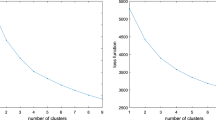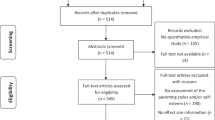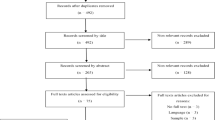Abstract
Background
Though associations between parenting styles marked by control (e.g., prevention of autonomous experiences) or rejection (e.g., criticism, arbitrary blame, and withholding of warmth) and youth anxiety have been established in the literature, few studies have examined cognitive mediators purported to explain these associations.
Objective
The present study explored relations among perceptions of maternal and paternal parenting, emotional self-efficacy (i.e., perceived control over negative emotion), and anxiety in adolescents and tested a mediational model in which emotional self-efficacy explains the relation between negative parenting styles and youth anxiety.
Methods
One hundred and twenty-four non-referred adolescents aged 12–18 completed questionnaires assessing study variables in school settings.
Results
Emotional self-efficacy and maternal rejection predicted anxiety, maternal control was a marginally significant predictor of anxiety, and paternal rejection and control were not associated with anxiety. Maternal rejection, but not paternal rejection or control by either parent, predicted emotional self-efficacy, and emotional self-efficacy mediated the relation between maternal rejection and anxiety.
Conclusions
Results offer support for a commonly cited theoretical pathway from maternal rejection to youth anxiety by teaching that positive emotional outcomes are rare and outside of the child’s control. Support was not found for a similarly theorized pathway from maternal control to youth anxiety through emotional self-efficacy. Findings point to a greater relation between youth anxiety and perceived negative parenting by mothers relative to fathers.
Similar content being viewed by others
References
Ballash, N., Leyfer, O., Buckley, A. F., & Woodruff-Borden, J. (2006a). Parental control in the etiology of anxiety. Clinical Child and Family Psychology Review, 9, 113–133. doi:10.1007/s10567-006-0007-z.
Ballash, N. G., Pemble, M. K., Usui, W. M., Buckley, A. F., & Woodruff-Borden, J. (2006b). Family functioning, perceived control, and anxiety: A mediational model. Journal of Anxiety Disorders, 20, 486–497. doi:10.1016/j.janxdis.2005.05.002.
Bandura, A. (1997). Self-efficacy: The exercise of control. New York: Freeman.
Baron, R. M., & Kenny, D. A. (1986). The moderator-mediator variable distinction in social psychological research: Conceptual, strategic, and statistical considerations. The Journal of Personality and Social Psychology, 24, 187–203. doi:10.1037/0022-3514.51.6.1173.
Bögels, S., & Brechman-Toussaint, M. (2006). Family issues in child anxiety: Attachment, family functioning, parental rearing and beliefs. Clinical Psychology Review, 26, 834–856. doi:10.1016/j.cpr.2005.08.001.
Bögels, S. M., & van Melick, M. (2004). The relationship between child-report, parent self-report, and partner report of perceived parental rearing behaviors and anxiety in children and parents. Personality and Individual Differences, 37, 1583–1596. doi:10.1016/j.paid.2004.02.014.
Boyd, C. P., Gullone, E., Kostanski, M., Ollendick, T. H., & Shek, D. L. (2000). Prevalence of anxiety and depression in Australian adolescents: Comparisons with worldwide data. Journal of Genetic Psychology, 161, 479.
Castro, J., Toro, J., Van der Ende, J., & Arrindell, W. A. (1993). Exploring the feasibility of assessing perceived parental rearing styles in Spanish children with the EMBU. International Journal of Social Psychiatry, 39, 47–57. doi:10.1177/002076409303900105.
Chorpita, B. F., & Barlow, D. H. (1998). The development of anxiety: The role of control in the early environment. Psychological Bulletin, 124, 3–21. doi:10.1037/0033-2909.124.1.3.
Chorpita, B. F., Brown, T. A., & Barlow, D. H. (1998). Perceived control as a mediator of family environment in etiological models of childhood anxiety. Behavior Therapy, 29, 457–476. doi:10.1016/S0005-7894(98)80043-9.
Costa, N. M., & Weems, C. F. (2005). Maternal and child anxiety: Do attachment beliefs or children’s perceptions of maternal control mediate their association? Social Development, 14, 574–590. doi:10.1111/j.1467-9507.2005.00318.x.
Costa, N. M., Weems, C. F., Pellerin, K., & Dalton, R. (2006). Parenting stress and childhood psychopathology: An examination of specificity to internalizing and externalizing symptoms. Journal of Psychopathology and Behavioral Assessment, 28, 113–122. doi:10.1007/s10862-006-7489-3.
Costa, N. M., Weems, C. F., & Pina, A. A. (2009). Hurricane Katrina and youth anxiety: The role of perceived attachment beliefs and parenting behaviors. Journal of Anxiety Disorders, 23, 935–941. doi:10.1016/j.janxdis.2009.06.002.
Creveling, C. C., Varela, R. E., Weems, C. F., & Corey, D. M. (2010). Maternal control, cognitive style, and childhood anxiety: A test of a theoretical model in a multi-ethnic sample. Journal of Family Psychology, 24, 439–448. doi:10.1037/a0020388.
Downey, R. G., & King, C. V. (1998). Missing data in Likert ratings: A comparison of replacement methods. Journal of General Psychology, 125, 175–191. doi:10.1080/00221309809595542.
Gallagher, B., & Cartwright-Hatton, S. (2008). The relationship between parenting factors and trait anxiety: Mediating role of cognitive errors and metacognition. Journal of Anxiety Disorders, 22, 722–733. doi:10.1016/j.janxdis.2007.07.006.
Gerlsma, C., Emmelkamp, P. M., & Arrindell, W. A. (1990). Anxiety, depression, and perception of early parenting: A meta-analysis. Clinical Psychology Review, 10, 251–277. doi:10.1016/0272-7358(90)90062-F.
Ginsburg, G. S., Siqueland, L., Masia-Warner, C., & Hedtke, K. A. (2004). Anxiety disorders in children: Family matters. Cognitive and Behavioral Practice, 11, 28–43. doi:10.1016/S1077-7229(04)80005-1.
Ginsburg, G. S., Keeton, C. P., Drazdowski, T. K., & Riddle, M. A. (2011). The utility of clinician’s ratings of anxiety using the Pediatric Anxiety Rating Scale (PARS). Child & Youth Care Forum, 40, 93–105. doi:10.1007/s10566-010-9125-3.
Hale, W. M., Engles, R., & Meeus, W. (2006). Adolescent’s perceptions of parenting behaviours and its relationship to adolescent generalized anxiety disorder symptoms. Journal of Adolescence, 29, 407–417. doi:10.1016/j.adolescence.2005.08.002.
Halme, N., Åstedt-Kurki, P., & Tarkka, M. (2009). Fathers’ involvement with their preschool-age children: How fathers spend time with their children in different family structures. Child & Youth Care Forum, 38, 103–119. doi:10.1007/s10566-009-9069-7.
Hawthorne, G., & Elliott, P. (2005). Imputing cross-sectional missing data: Comparison of common techniques. Australian and New Zealand Journal of Psychiatry, 39, 583–590. doi:10.1111/j.1440-1614.2005.01630.x.
Holmbeck, G. N. (2002). Post-hoc probing of significant moderational and mediational effects in studies of pediatric populations. Journal of Pediatric Psychology, 27, 87–96. doi:10.1093/jpepsy/27.1.87.
Hudson, J. L., & Rapee, R. M. (2001). Parent-child interactions and anxiety disorders: An observational study. Behavior Research and Therapy, 39, 1411–1427. doi:10.1016/S0005-7967(00)00107-8.
Hudson, J. L., Comer, J. S., & Kendall, P. C. (2008). Parental responses to positive and negative emotions in anxious and nonanxious children. Journal of Clinical Child & Adolescent Psychology, 37, 303–313. doi:10.1080/15374410801955839.
Landon, T. M., Ehrenreich, J. T., & Pincus, D. B. (2007). Self-efficacy: A comparison between clinically anxious and non-referred youth. Child Psychiatry and Human Development, 38, 31–45. doi:10.1007/s10578-006-0038-1.
Lindhout, I. E., Markus, M. T., Borst, S. R., Hoogendijk, T. H. G., Dingemans, P. M. A. J., & Boer, F. (2009a). Childrearing style in families of anxiety-disordered children: Between family and within-family differences. Child Psychiatry and Human Development, 40, 197–212. doi:10.1007/s10578-008-0120-y.
Lindhout, I. E., Markus, M. T., Hoogendijk, T. G., & Boer, F. (2009b). Temperament and parental child-rearing style: Unique contributions to clinical anxiety disorders in childhood. European Child and Adolescent Psychiatry, 18, 439–446. doi:10.1007/s00787-009-0753-9.
McDonald, K. L., Bowker, J. C., Rubin, K. H., Laursen, B., & Duchene, M. S. (2010). Interactions between rejection sensitivity and supportive relationships in the prediction of adolescents’ internalizing difficulties. Journal of Youth and Adolescence, 39, 563–574. doi:10.1007/s10964-010-9519-4.
McLeod, B. D., Weisz, J. R., & Wood, J. J. (2007a). Examining the association between parenting and childhood depression: A meta-analysis. Clinical Psychology Review, 27, 986–1003. doi:10.1016/j.cpr.2007.03.001.
McLeod, B. D., Wood, J. J., & Weisz, J. R. (2007b). Examining the association between parenting and childhood anxiety: A meta-analysis. Clinical Psychology Review, 27, 155–172. doi:10.1016/j.cpr.2006.09.002.
Muris, P. (2001). A brief questionnaire for measuring self-efficacy in youths. Journal of Psychopathology and Behavioral Assessment, 23, 145–149. doi:10.1023/A:1010961119608.
Muris, P. (2002). Relationships between self-efficacy and symptoms of anxiety disorders and depression in a normal adolescent sample. Personality and Individual Differences, 32, 337–348. doi:10.1016/S0191-8869(01)00027-7.
Muris, P., Merckelbach, H., Ollendick, T. H., King, N. J., & Bogie, N. (2002). Three traditional and three new childhood anxiety questionnaires: Their reliability and validity in a normal adolescent sample. Behaviour Research and Therapy, 40, 753–772. doi:10.1016/S0005-7967(01)00056-0.
Muris, P., Meesters, C., & van Brakel, A. (2003a). Assessment of anxious rearing behaviors with a modified version of “Egna Minnen Beträffande Uppfostran” questionnaire for children. Journal of Psychopathology and Behavior Assessment, 25, 229–237. doi:10.1023/A:1025894928131.
Muris, P., Schouten, E., Meesters, C., & Gijsbers, H. (2003b). Contingency-competence-control-related beliefs and symptoms of anxiety and depression in a young adolescent sample. Child Psychiatry and Human Development, 33, 325–339. doi:10.1023/A:1023040430308.
Muris, P., Meesters, C., Schouten, E., & Hoge, E. (2004). Effects of perceived control on the relationship between perceived parental rearing behaviors and symptoms of anxiety and depression in nonclinical preadolescents. Journal of Youth and Adolescence, 33, 51–58. doi:10.1023/A:1027334314021.
Ollendick, T. H., & King, N. J. (1994). Diagnosis, assessment, and treatment of internalizing problems in children: The role of longitudinal data. Journal of Consulting and Clinical Psychology, 62, 918–927. doi:10.1037/0022-006X.62.5.918.
Perris, C., Jacobsson, L., Lindstrom, H., von Knorring, L., & Perris, H. (1980). Development of a new inventory for assessing memories of parental rearing behaviour. Acta Psychiatrica Scandinavica, 61, 265–274. doi:10.1111/j.1600-0447.1980.tb00581.x.
Peterson, C., & Stunkard, A. J. (1992). Cognates of personal control: Locus of control, self-efficacy, and explanatory style. Applied and Preventive Psychology, 1, 111–117. doi:10.1016/S0962-1849(05)80151-9.
Rapee, R. M. (1997). The potential role of childrearing practices in the development of anxiety and depression. Clinical Psychology Review, 17, 47–67. doi:10.1016/S0272-7358(96)00040-2.
Reynolds, C. R. (1980). Concurrent validity of “What I Think and Feel:” The Revised Children’s Manifest Anxiety Scale. Journal of Counseling and Clinical Psychology, 48, 774–775. doi:10.1037/0022-006X.48.6.774.
Reynolds, C. R., & Paget, K. D. (1981). Factor analysis of the revised children’s manifest anxiety scale for Blacks, Whites, males, and females with a national normative sample. Journal of Consulting and Clinical Psychology, 49, 352–359. doi:10.1037/0022-006X.49.3.352.
Reynolds, C. R., & Richmond, B. O. (1978). “What I Think and Feel:” A revised measure of children’s manifest anxiety. Journal of Abnormal Child Psychology, 6, 271–280. doi:10.1007/BF00919131.
Reynolds, C. R., & Richmond, B. O. (1979). Factor structure and construct validity of “What I Think and Feel:” The Revised Children's Manifest Anxiety Scale. Journal of Personality Assessment, 43, 281–283. doi:10.1207/s15327752jpa4303_9.
Reynolds, C. R., & Richmond, B. O. (1985). Revised Children's Manifest Anxiety Scale. RCMAS manual. Los Angeles: Western Psychological Services.
Seligman, L. D., Ollendick, T. H., Langley, A. K., & Baldacci, H. B. (2004). The utility of measures of child and adolescent anxiety: A meta-analytic review of the revised children’s anxiety scale, the state-trait anxiety inventory for children, and the child behavior checklist. Journal of Clinical Child and Adolescent Psychology, 33, 557–565. doi:10.1207/s15374424jccp3303_13.
Suldo, S. M., & Shaffer, E. J. (2007). Evaluation of the Self Efficacy Questionnaire for Children in two samples of American adolescents. Journal of Psychoeducational Assessment, 25, 341–355. doi:10.1177/0734282907300636.
van der Bruggen, C. O., Stams, G. M., Bögels, S. M., & Paulussen-Hoogeboom, M. C. (2010). Parenting behaviour as a mediator between young children’s negative emotionality and their anxiety/depression. Infant and Child Development, 19, 354–365. doi:10.1002/icd.665.
van Gastel, W. W., Legerstee, J. S., & Ferdinand, R. F. (2009). The role of perceived parenting in familial aggregation of anxiety disorders in children. Journal of Anxiety Disorders, 23, 46–53. doi:10.1016/j.janxdis.2008.03.014.
Weems, C. F., & Silverman, W. K. (2006). An integrative model of control: Implications for understanding emotion regulation and dysregulation in childhood anxiety. Journal of Affective Disorders, 91, 113–124. doi:10.1016/j.jad.2006.01.009.
Weiss, D. D., & Last, C. G. (2001). Developmental variations in the prevalence and manifestations of anxiety disorders. In M. W. Vasey & M. R. Dadds (Eds.), The developmental psychopathology of anxiety (pp. 27–42). New York: Oxford University Press.
Weisz, J. R., & Stipek, D. J. (1982). Competence, contingency, and the development of perceived control. Human Development, 25, 250–281. doi:10.1159/000137749.
Wood, J. J., McLeod, B. D., Sigman, M., Hwang, W., & Chu, B. C. (2003). Parenting and childhood anxiety: Theory, empirical findings, and future directions. Journal of Child Psychology and Psychiatry, 44, 134–151. doi:10.1111/1469-7610.00106.
Yahav, R. (2006). The relationship between children’s and adolescents’ perceptions of parenting style and internal and external symptoms. Child: Care, Health and Development, 33, 460–471. doi:10.1111/j.1365-2214.2006.00708.x.
Author information
Authors and Affiliations
Corresponding author
Rights and permissions
About this article
Cite this article
Niditch, L.A., Varela, R.E. Perceptions of Parenting, Emotional Self-Efficacy, and Anxiety in Youth: Test of a Mediational Model. Child Youth Care Forum 41, 21–35 (2012). https://doi.org/10.1007/s10566-011-9150-x
Published:
Issue Date:
DOI: https://doi.org/10.1007/s10566-011-9150-x




